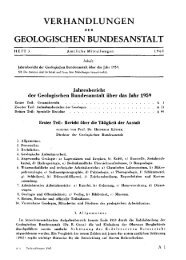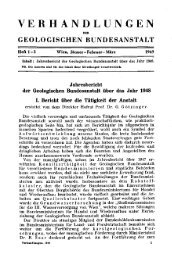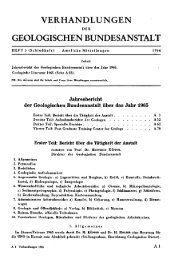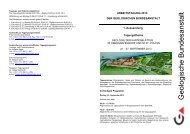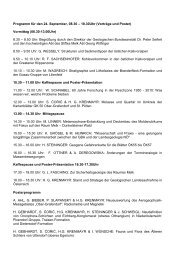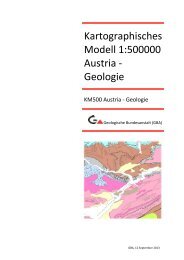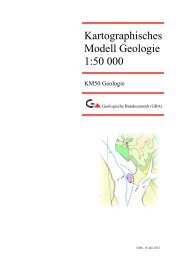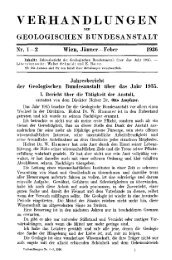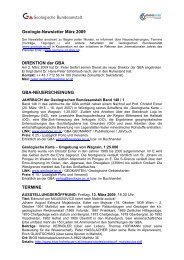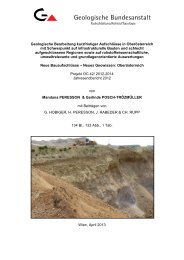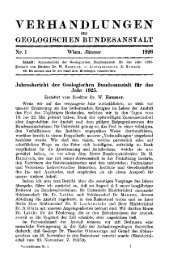Field Trip B TRIASSIC CONODONT LOCALITIES OF THE ...
Field Trip B TRIASSIC CONODONT LOCALITIES OF THE ...
Field Trip B TRIASSIC CONODONT LOCALITIES OF THE ...
You also want an ePaper? Increase the reach of your titles
YUMPU automatically turns print PDFs into web optimized ePapers that Google loves.
localities (Taubenstein, Leislingwand near Raschberg) both forming stratigraphically isolated fissure deposits.<br />
Choristoceras hauen is a long ranging species and occurs both in the Upper Norian and in the<br />
Rhaetian. Therefore it serves no place in a standard zonation. The Reticulatus Subzone correlates with<br />
the Cochloceras Subzone of TOZER 1967 and the Cochloceras suessi Zone of KOZUR, respectively.<br />
At the top of the so defined Suessi Zone the major part of Triassic ammonites belonging to subordo<br />
Trachyceratina disappears and only some Ceratitinas (Cycloceltites, Rhabdoceras, Choristoceras, Vandaites)<br />
and the long ranging leiostracean genera Arcestes, Placites, Cladiscites, Rhacophyllites andMegaphyllites<br />
survive into the lower Rhaetian.<br />
For the Rhaetian Marshi Zone a two fold division has been proposed by WIEDMANN & KRYSTYN<br />
(in WIEDMANN et al. 1979, p. 145). The base of the newly defined Marshi Zone is marked by the appearance<br />
of Vandaites stuerzenbaumi (BOECKH), simplified described as a „helicoid choristoceras".<br />
Another distinct ammonite species of the lower subzone is Eopsiloceras planorboides (GUEMBEL). At<br />
the end of the subzone some more ammonoid genera disappear. Thus the impure fauna of the topmost<br />
Triassic Marshi Subzone consists of not more than the four genera Choristoceras, Arcestes, Rhacophyllites<br />
and Megaphyllites. The two subzones have been found in a vertical sequence within different sections<br />
of the Alpine Koessen Beds.<br />
A revised North American biochronological scale for the interval between the Middle Norian and the<br />
Jurassic has been provided by E. T. TOZER 1979. This new division comprises three zones which are<br />
in ascending order the Cordilleranus, Amoenum and Crickmayi Zones. They can be exactly correlated<br />
with the Alpine Quinquepunctatus, Reticulatus and Stuerzenbaumi Subzones. A remarkable fact at<br />
present, however, is the missing of an equivalent of the topmost Triassic in North America.<br />
Conodont zonation<br />
General remarks<br />
This section treats with some 10 species of platform conodonts assigned to the form genera Gladigondolella,<br />
Gondolella, Metapolygnathus and Epigondolella, their phylogenetic relationships are outlined<br />
in fig. 6. In addition two species of the „neospathodid" genus Misikella KOZUR & MOCK are discussed.<br />
Most of these species have been described during the past 10 years, either based on too few specimens<br />
or with unprecise and even wrong stratigraphic ranges (HAYASHI1968, KOZUR 1972). Due to<br />
the fact that the ontogenetic evolution of many species has not been treated to such an extent as is<br />
needed specific identification of Upper Triassic platform conodonts is highly problematic at present.<br />
Hence, the author has followed no other currently applied concepts than the one suggested by MO-<br />
SHER 1968. Several taxa can be revised on the basis of our collections available and notes on these<br />
species are given in the following paragraphs. However, this paper is intended to provide a summary of<br />
stratigraphy and thus, systematic treatment of the categories are not included here.<br />
RHAETIAN<br />
SEVATIAN<br />
ALAUN IAN<br />
2<br />
1<br />
2<br />
1 I<br />
3<br />
LACIAN 2<br />
TUVALIAN<br />
1<br />
W 1<br />
ergensi<br />
I a<br />
G.navici<br />
1<br />
hiformis<br />
isis<br />
ulata<br />
D '<br />
6<br />
a<br />
••iM.comm<br />
primitia<br />
3<br />
Ol ol<br />
2 d^^<br />
3 .2<br />
^ -a<br />
s s<br />
s s<br />
i 1<br />
in<br />
1 "••^<br />
a<br />
1 *<br />
c<br />
1 -o<br />
a<br />
l LÜ<br />
\k E.postera E.postera E.postera<br />
Fig. 6: Phylogenetic diagram of Upper Triassic platform conodonts.<br />
E.bidentata<br />
75



